RB Leipzig’s season has been one that has surprised much of the Bundesliga. In Julian Nagelsmann’s first year, the club spent much of the season either at the top of the Bundesliga or in second, never dropping out of the top three once they arrived there ten weeks into the season. While Timo Werner has attracted much of the attention with what seems like an impending transfer, Marcel Sabitzer has risen to be one of Leipzig’s most important players. The Austrian began the season as a right-winger, registering seven goals and six assists while playing out wide. However, since the December 17th match against Borussia Dortmund, Sabitzer has played a more central role, either as a centre midfielder or attacking midfielder.
This scout report provides a tactical analysis of how Sabitzer’s new role in the centre of the pitch fits into Nagelsmann’s tactics at RB Leipzig. While his goals and assist output has waned, the analysis shows that his role under Nagelsmann has become vital, with Sabitzer logging the most minutes of any RB Leipzig player this season, including goalkeeper Péter Gulácsi.
Pressing ability
Sabitzer’s pressing ability may have been one of the major reasons that Nagelsmann looked to move him into a more central role. His ability to put pressure on players across the pitch allows him to often win back balls for Leipzig and then the lightning-quick attack begins. His speed is often underestimated, which he manipulates to win the ball back. He did just this against Bayern Munich in their first match this season.
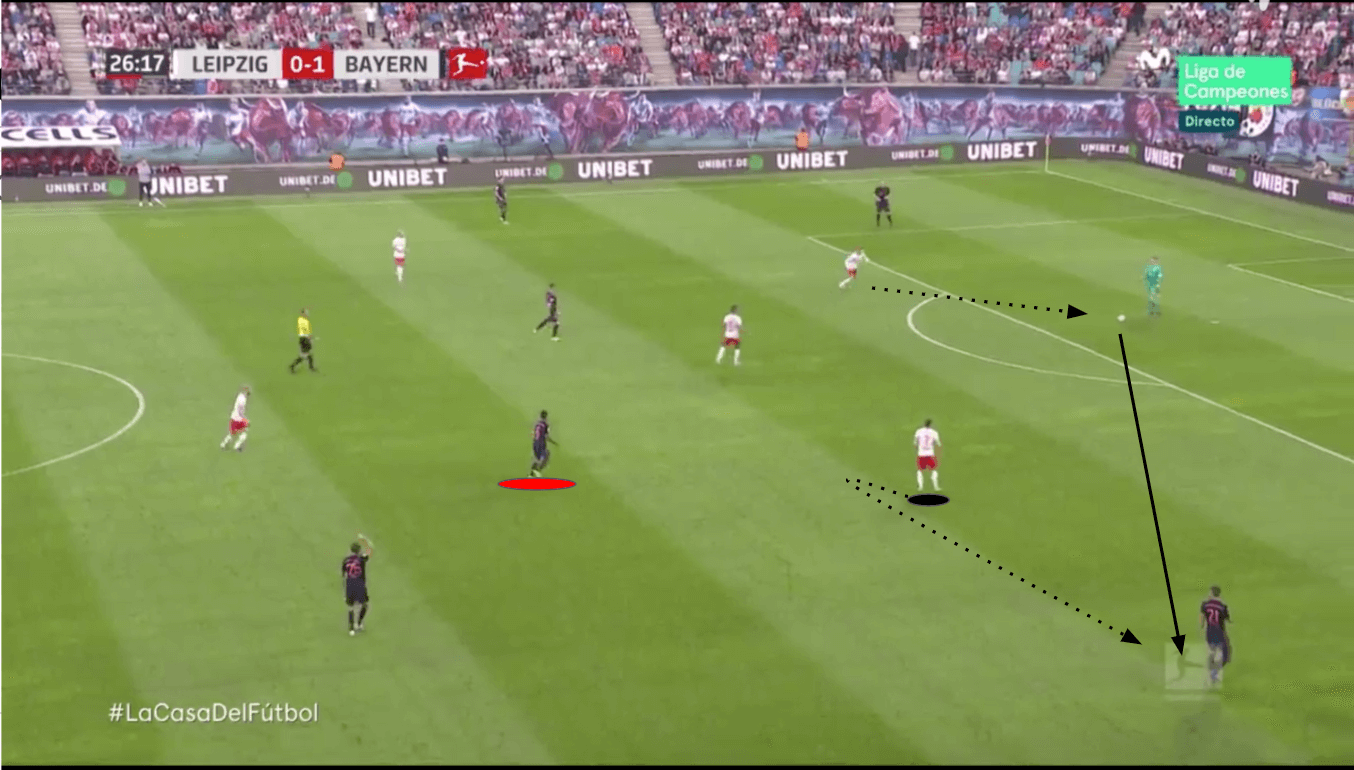
In the match, Manuel Neuer had the ball at his feet, with Sabitzer, marked in black, pressing higher up the pitch on the right side. As Neuer was scanning the pitch for options, Sabitzer took two steps to his left, seeming as if he were to use his cover shadow to eliminate the player marked in red. As Neuer hesitated, Timo Werner applied pressure on him. This pressure, combined with Sabitzer’s movement forced Neuer to see Lucas Hernandez, the left-back, as a passing option. He played him the ball, and Sabitzer was quickly all over him. While Hernandez tried to go forward, Sabitzer forced him to turn around, at which point he got his body between Hernandez and the ball, and he was now in possession. Multiple times against Bayern, Sabitzer baited passes to Hernandez, who he was able to close down quickly and dispossess in dangerous areas.
Sabitzer also does well to protect space by using his cover shadow. This is an incredibly important skill for any central player because protecting the centre of the pitch is of the utmost importance for most managers, as most assists come from either the centre of the pitch or the half-spaces.
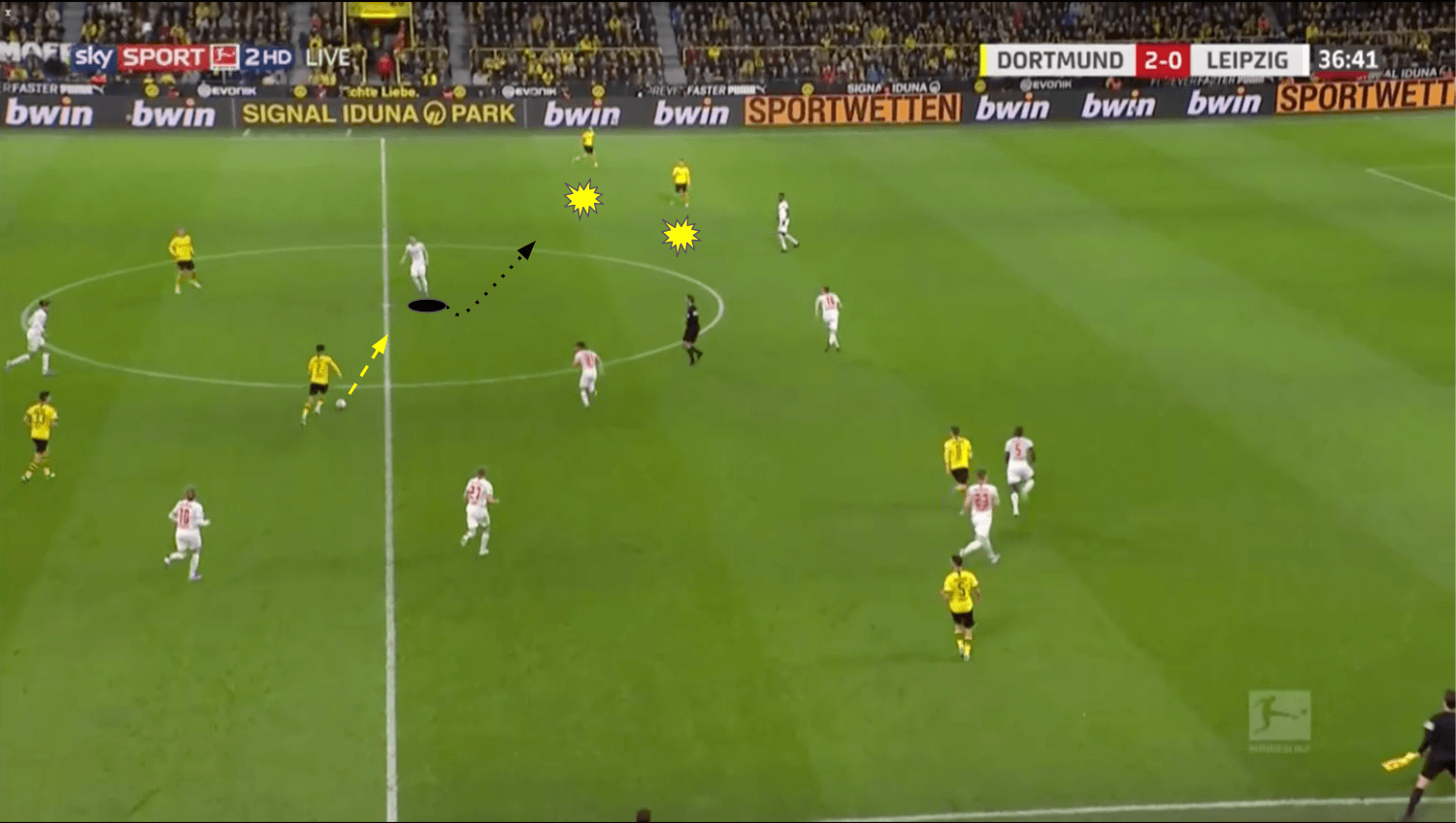
Against Borussia Dortmund, RB Leipzig found themselves quickly transitioning to their defensive phase as Jadon Sancho dribbled diagonally across the pitch. As Sancho did, Sabitzer began running by taking one step to his left and then backwards, still facing Sancho as he backpedaled. With this small movement, Sabitzer effectively cut off both passing options behind him. This caused Sancho to pause, as he wasn’t sure if Sabitzer would press him, and he now had no passing options. By the time Sancho had made up his mind to try and attempt a pass, Sabitzer was able to get close enough to deflect his attempted pass out of the way.
Not only had Sabitzer dispossessed Sancho, but he also protected the space behind him, which he does consistently as a midfielder. Any pass that is going to be played between him and a teammate needs to be played with incredible pace, because otherwise Sabitzer is capable of intercepting the ball when he doesn’t appear to be.
Playing forward out of pressure
One of the principles of play that seems to be strongly embedded at RB Leipzig under Julian Nagelsmann is the need to get forward as quickly as possible and take advantage of an opponent’s lack of organisation seconds after they have lost the ball. Marcel Sabitzer is the perfect embodiment of this principle.
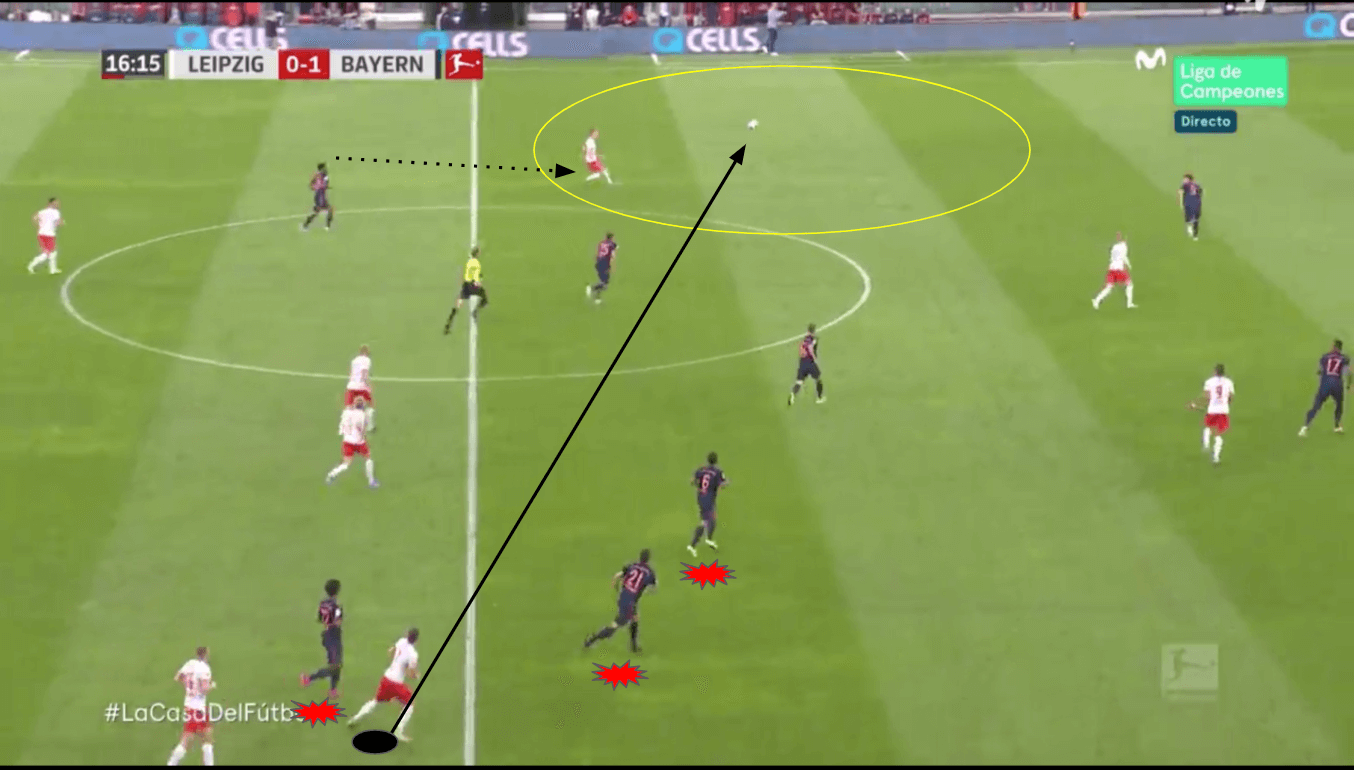
Here, against Bayern, Leipzig had just regained possession. Bayern began to counterpress immediately, looking to win back possession as quickly as possible. There are three Bayern defenders within close proximity of Sabitzer, with at least three more on the right side of the pitch. On the opposite side, a streaking Marcel Halstenberg found himself in space with only one defender in front of him. Halstenberg made his run, and Sabitzer, sensing the amount of pressure around him, put his foot through the ball as quickly as possible, ultimately overhitting his target. While unsuccessful here, this quick play out of pressure can catch teams off guard.
Against Bayern in their second match of the season, Sabitzer again played forward out of pressure quickly to cause a serious problem for Bayern Munich. Joshua Kimmich had just played a long ball towards Leipzig’s backline, where Angeliño used his first touch to play Sabitzer.
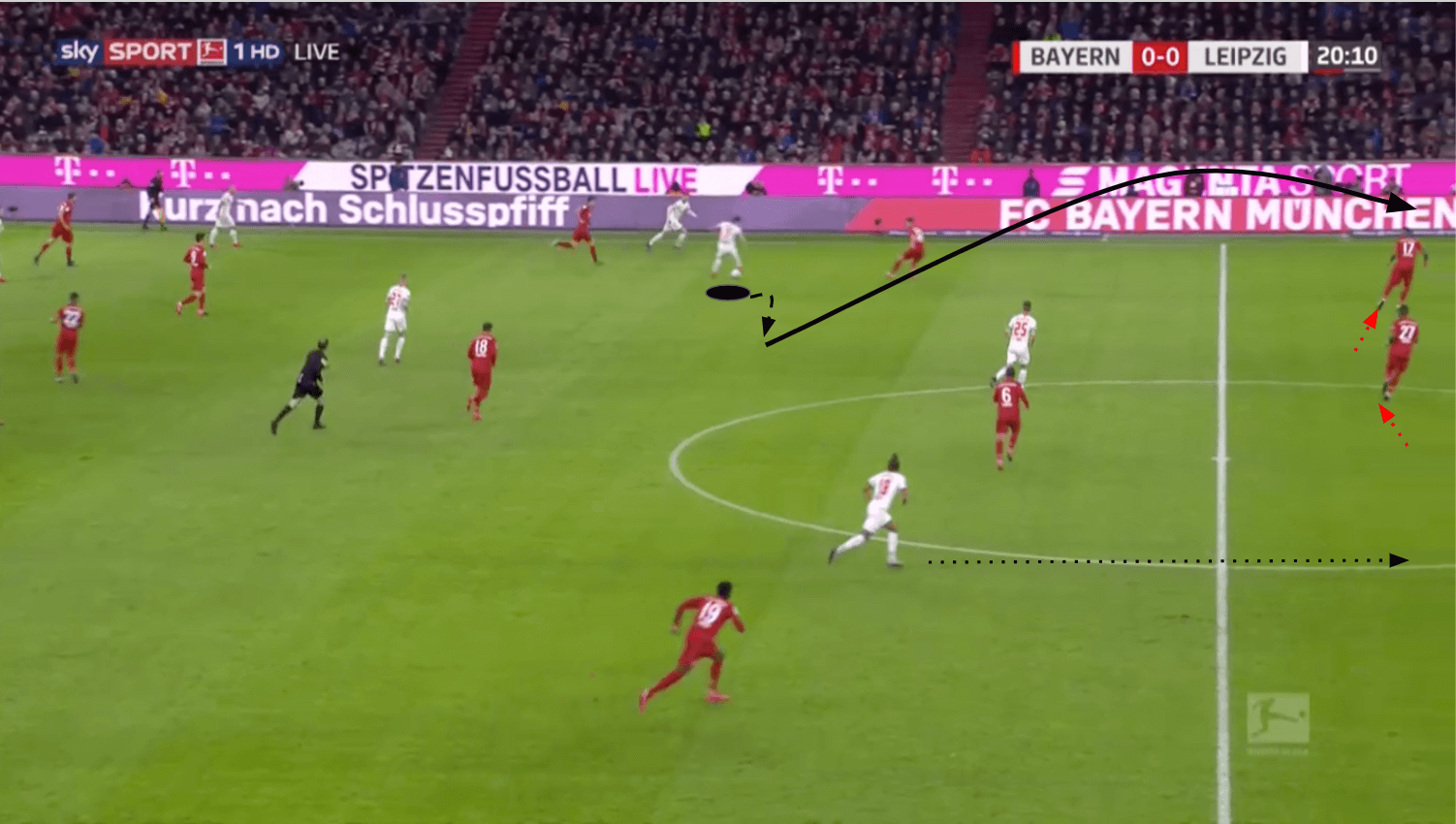
Realising the pressure he was under with six Bayern players nearby, Sabitzer turned inside with his first touch, preparing to strike a long ball out of pressure. As he did, Bayern’s centre-backs, David Alaba and Jérôme Boateng, both shifted towards the right. Christopher Nkunku saw the opening and dashed through, where Sabitzer’s long aerial pass was just barely behind him. Nkunku tried to use his chest to bring the ball down unsuccessfully, and Bayern were able to recover possession. This knack for finding space away from the ball and sensing pressure around the ball makes Sabitzer an ideal midfielder for Julian Nagelsmann.
Later in the same match against Bayern, Sabitzer again recognised pressure and again he was able to play away from it while still finding an option going forward. Dayot Upamecano made a marauding run up the right side of the pitch from outside his own penalty area. As he got into the attacking third, he misplayed a horizontal pass to Dani Olmo.
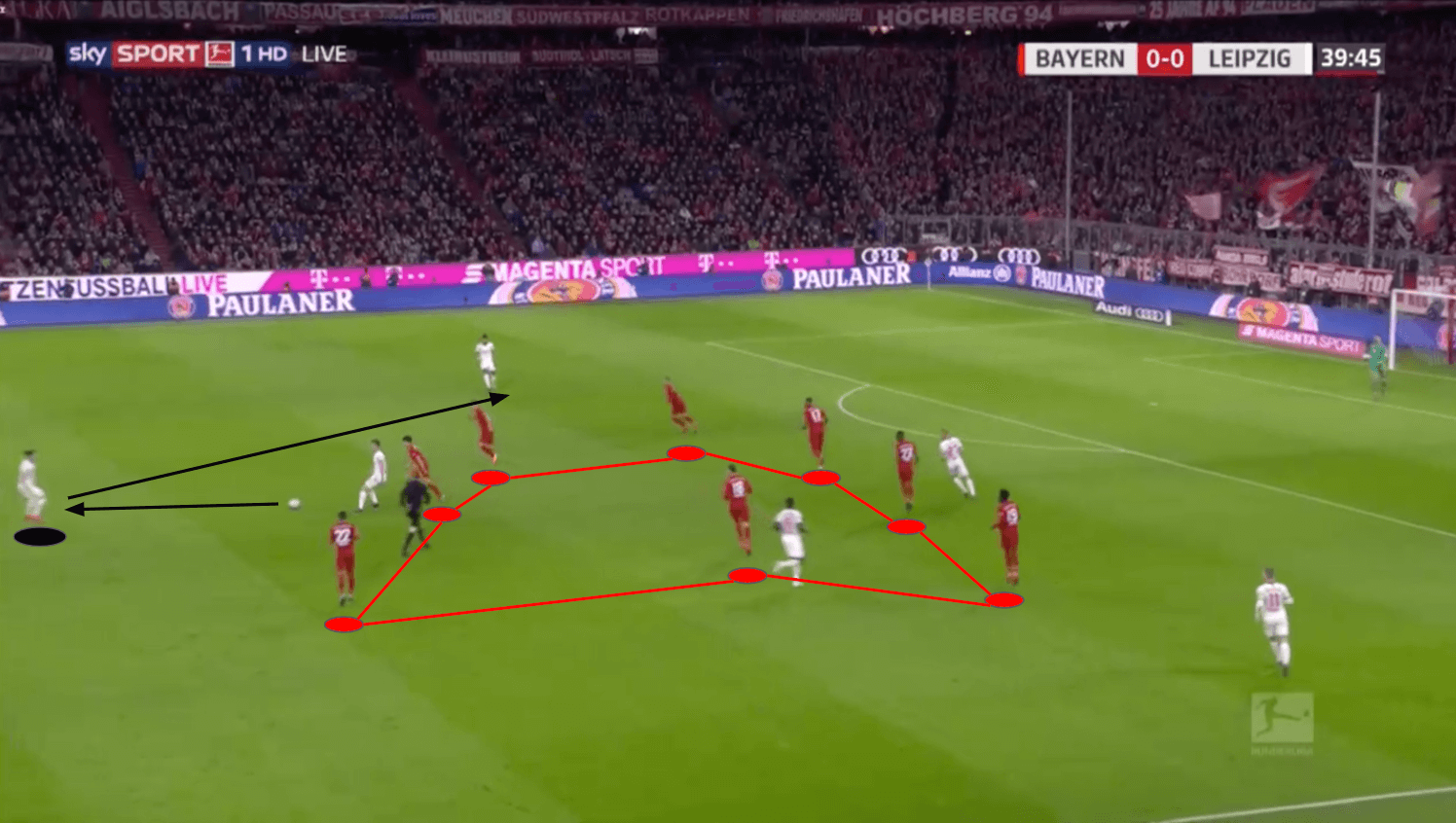
Olmo’s first touch betrayed him, and he was forced to go backwards. Sabitzer, who was trailing behind the action, entered as an option, and Olmo played the ball backwards. As a trailing player, Sabitzer would have been able to recognise the eight Bayern players who had retreated, all of who were on the right side of the pitch. With his first touch, Sabitzer pinged a pass on the ground to Nkunku, who was quickly overlapped by Angeliño. This allowed Leipzig to get into the penalty area and win a corner, a set piece which they’ve been quite effective from this season. All of this started from Sabitzer’s recognition of pressure and his ability to progress the ball forward and away from it quickly.
Long-distance scoring threat
Sabitzer is also a long-distance scoring threat for RB Leipzig, so much so that the Bundesliga put out a video of his ‘Top 5 Long-Range Goals so far in 2019/20’. While he certainly can hit the ball sweetly and with pace, part of his scoring threat comes from his knack for arriving ‘late’ and not being recognised by any members of the opposing defence. Against Bayern, he did just this in what was one of the best chances of the match when Leipzig played Bayern back in September.
Bayern were attempting to play the ball out of the back on the right side, which was disrupted by Leipzig’s press. As soon as they won possession, Leipzig looked to go forward, which was unavailable. Their next option was to switch the side of attack.
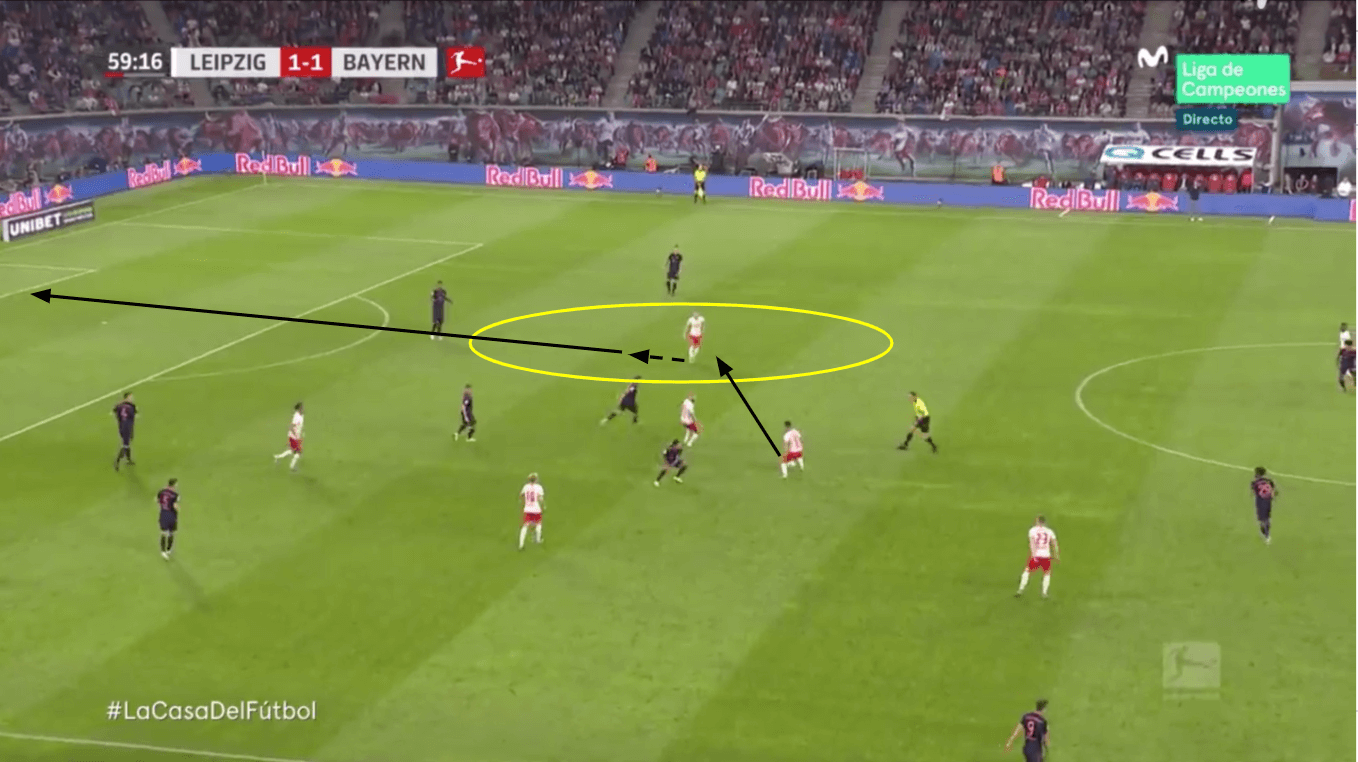
The entire time Leipzig attacked on the left side of the pitch, Sabitzer continually operated in the space where he received the ball. Due to Leipzig’s compact shape combined with this being a period of transition, Bayern were unable to mark Sabitzer with a midfielder. If a defender stepped forward to do so, he would be leaving a lot of vulnerable space inside the penalty area open. This led to Sabitzer getting a free shot at goal: one he absolutely put his laces through. The spin-less ball swerved from left to right, and Maneul Neuer did incredibly well to save it by swinging his arm up and deflecting it with his bicep.
Against Dortmund in December, Sabitzer took advantage of Leipzig’s compact attacking movement to find himself in a familiar space, this time closer to goal. As Timo Werner dribbled and laid the ball off to Christopher Nkunku, Sabitzer again trailed behind the play, allowing Dortmund’s midfield to forget about him.
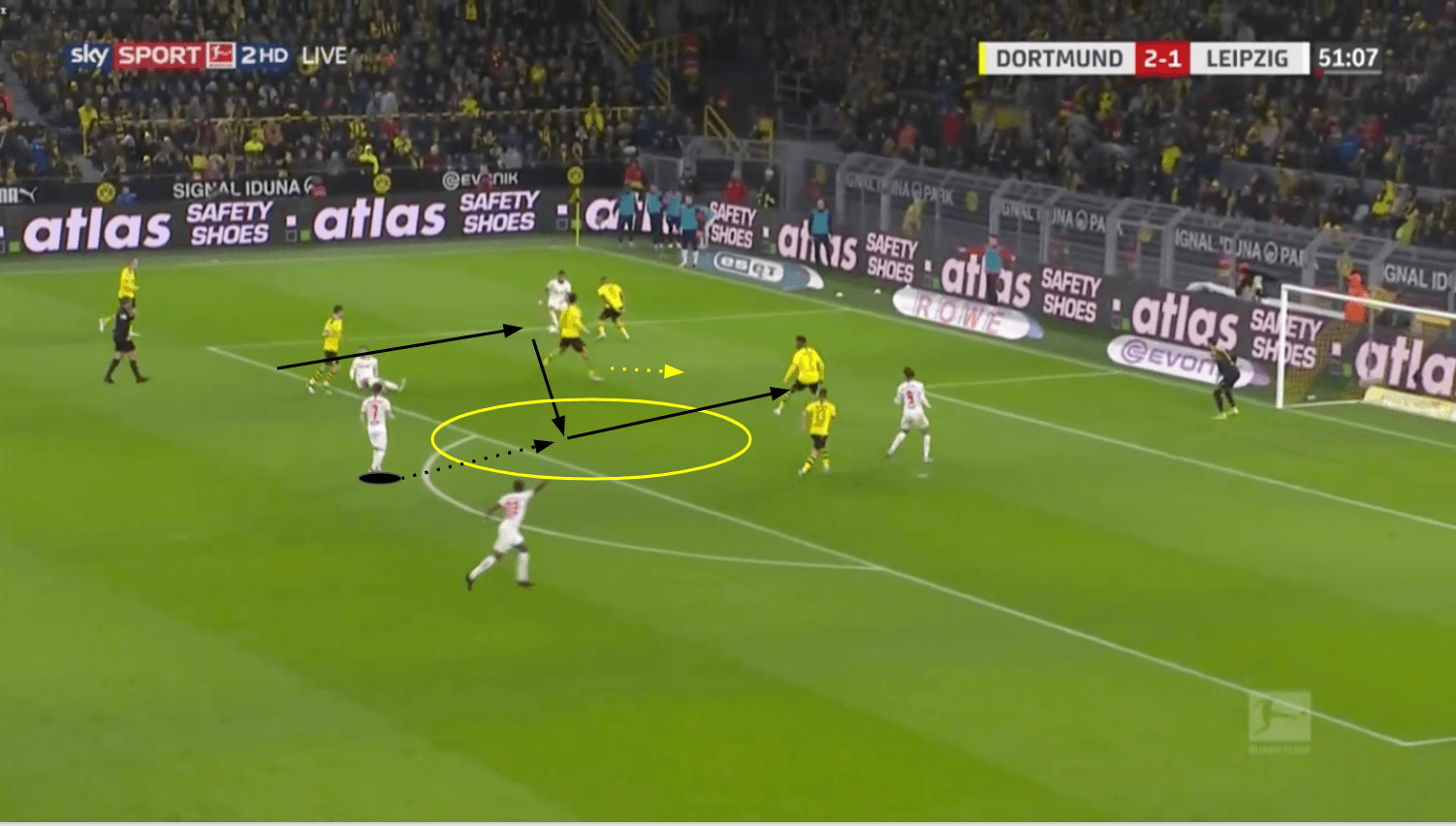
As Dortmund quickly dropped to keep pace with Leipzig, a passing lane across the Dortmund defence opened up, revealing a large amount of space to be exploited. Sabitzer sped forward in this moment, and Nkunku played a perfect pass to his right foot. Sabitzer’s shot was ultimately blocked by Dan-Axel Zagadou, preventing Leipzig from tying the match.
Playing from the half-space
While Sabitzer is obviously a scoring threat from the space at the top of the penalty area, he also has the ability to play from the half-space. This ability to get into these areas can cause defences all types of problems, especially when the man in that space has a video put out by the league dedicated to his long-range goals. Defences cannot afford to allow him to shoot the ball, which means a defender must step up to pressure, creating space for Sabitzer to play the ball into somewhere else in the attacking third.
The first example comes at the end of a classic ‘up, back, and through’ passing pattern. One of the principles that Leipzig seems to emphasise is a short lay-off pass after a long pass. The long pass changes the position of attack rather quickly. The short pass almost always comes off a player’s first touch. The player making that pass usually has his back facing his goal, which brings about the importance of the lay-off. The ball is played to a forward-facing player, who can then execute another vertical ball and devastate the defence.
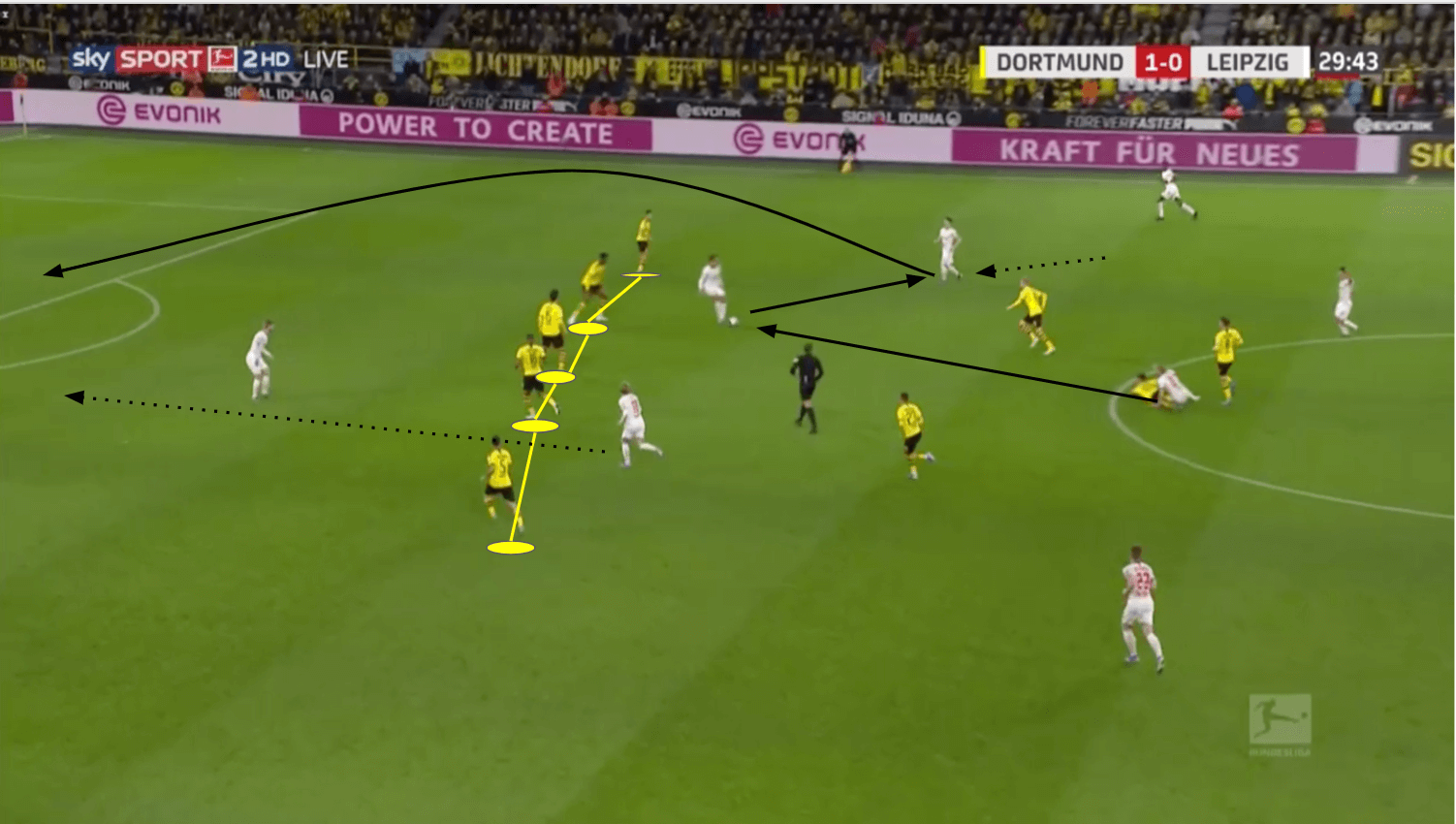
Sabitzer recognised the opportunity to complete this third man movement against Dortmund. Konrad Laimer played a long pass to Yussuf Poulsen. As the ball to Poulsen was moving, Sabitzer rushed into the half-space to support Poulsen and receive the lay-off. As Sabitzer moved forward, Emil Forsberg, knowing Sabitzer’s tendency to quickly play vertical or diagonal balls, made his run behind the Dortmund defence. While Sabitzer was able to identify the open space to play into, he wasn’t able to get the ball there quick enough, opting to take a touch, which allowed Manuel Akanji, one of Dortmund’s centre-backs, to recognise and pick up Forsberg’s run, ultimately heading the ball out.
Against Bayern Munich in February, Sabitzer again demonstrated his ability to operate in the half-space, when he received a pass from Dani Olmo just outside the centre of the pitch.
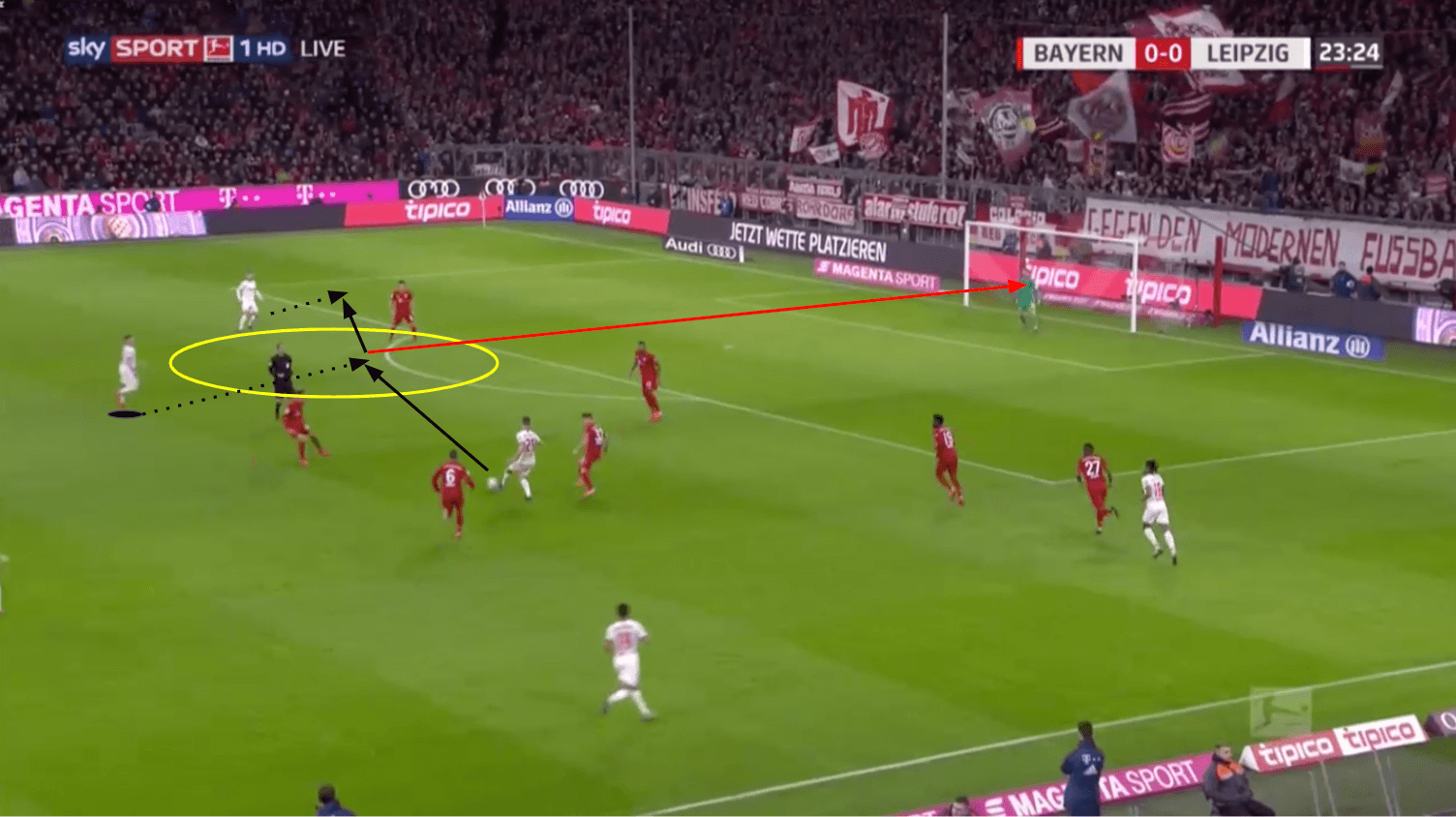
When the ball came in from Olmo, Sabitzer’s positioning and ability to strike the ball well forced Benjamin Pavard to make a tough decision: either step forward or allow Sabitzer to shoot. Pavard stepped forward, preventing the shot (red arrow) and opening up Timo Werner as an option. Werner’s first touch popped the ball into the air, and Jérôme Boateng had enough time to force Werner into a less than desirable shot at the near post, which he ultimately put into the exterior of the side-netting for a goal kick.
While these chances were not fully taken advantage of for one reason or another, Sabitzer’s ability to play both aerial and ground passes from the half-space make him a perfect player for Nagelsmann’s style of play.
Conclusion
Sabitzer is the perfect representation of what RB Leipzig have become under Julian Nagelsmann. He is a fast, forward-thinking player who runs his legs off to press effectively while also taking advantage of the space that Leipzig creates when attacking. Consequently, it’s no surprise that he has been captaining the team since January. While most of his goals and assists have dried up since he transitioned from the right wing to a more central role, his contributions to Leipzig’s successful season have continued to increase in number as the season goes on. When the Bundesliga season returns, Sabitzer will look to galvanise his club and close the gap on Bayern Munich, who currently sit five points ahead of RB Leipzig.





Comments